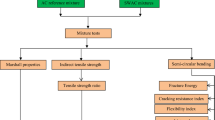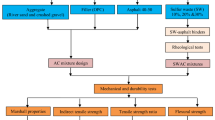Abstract
Electric-arc-furnace (EAF) steelmaking uses scrap iron and steel as raw materials. Scrap iron and steel originate from complex sources and may contain heavy metal components which can leach into the environment over time due to wear-and-tear. A by-product of the EAF steelmaking process is oxidizing slag, and approximately 1.2 million metric tons is produced every year in Taiwan alone. This study investigated substitution of natural aggregates with oxidizing slag in dense-graded asphalt concrete. We evaluated the water resistance and asphalt film thickness of the oxidizing slag substituted asphalt concrete and further explored the performance of oxidizing slag as paving material. We determined the dissolved and total amounts of heavy metals in the oxidizing slag, comparing these results with current regulatory controls to assess the environmental compatibility of the oxidizing slag. We found that due to the complicated sources of oxidizing slag, the basic properties should be analyzed on a batch-to-batch basis. Furthermore, we recommend trial mixing before upscaling the production of oxidizing slag substituted dense-graded asphalt concrete to confirm the mixing time required to achieve uniformity. The results also show that in comparison to natural aggregates used in asphalt concrete, oxidizing slag exhibits superior performance in terms of increased asphalt film thickness and improved water resistance. Furthermore, oxidizing slag as an aggregate material was associated with decreased heavy metal leaching and reduced environmental pollution. The results of the toxicity characteristic leaching procedure (TCLP) met regulatory requirements. However, the microwave-assisted aqua-regia digestion procedure showed heavy metal concentrations exceeding the monitoring standards for food crops. Considering environmental compatibility, it is recommended that controlling the total amount of heavy metals in oxidizing slag should be included in regulatory requirements. Furthermore, we should prohibit the use of materials such as oxidizing slag and other steel furnace slag in the roadways adjacent to edible crop farmlands.




Similar content being viewed by others
Data availability
The datasets used and/or analyzed during the current study are available from the corresponding author on reasonable request.
References
Alinezhad M, Sahaf A (2019) Investigation of the fatigue characteristics of warm stone matrix asphalt (WSMA) containing electric arc furnace (EAF) steel slag as coarse aggregate and Sasobit as warm mix additive. Case Stud Constr Mater 11:e00265
Al-Khateeb G, Sukkari A, Zeiada W, Ezzat H (2023) Microscopy-based approach for measuring asphalt film thickness and its impact on hot-mix asphalt performance. Case Stud Constr Mater 18:e01711
Australian Asphalt Pavement Association (2004) Asphalt mix design - a guide to the process of design and selection of an asphalt job mix (Implementation Guide IG-8), Australia. p 28
Campen WH, Smith JR, Erickson LG, Mertz LR (1959) The relationship between voids, surface area, film thickness, and stability in bituminous paving mixtures. In Proceeding of the Association of Asphalt Paving Technologists (AAPT), vol 28. pp 149–178
Chang JR, Chien HT (2019) The effects of replacing fine aggregates with oxidizing slag on asphalt film thickness. In: 11th International Conference on Road and Airfield Pavement Technology. Kuala Lumpur, Malaysia, p 12
China Steel Corporation (CSC) (2017) Manual of the basic oxygen furnace slag for asphalt concrete pavement. p 368. (in Chinese)
Environmental Protection Administration (EPA) (2011a) Executive Yuan. Taiwan, Standards for Soil Pollution Control
Environmental Protection Administration (EPA) (2011b) Executive Yuan. Taiwan, Standards for Soil Pollution Monitor
Environmental Protection Administration (EPA) (2017) Executive Yuan, Taiwan, Toxicity characteristic leaching procedure (NIEA R201.15C), Taiwan, p 27. [Online]. Available from: https://www.moenv.gov.tw/nera/D650FF755904A079. Accessed 8 May 2024. (in Chinese)
Environmental Protection Administration (EPA) (2019) Executive Yuan, Taiwan, Microwave-assisted aqua-regia digestion (NIEA S301.61B), Taiwan, p 13. [Online]. Available from: https://www.moenv.gov.tw/nera/D650FF755904A079. Accessed 8 May 2024. (in Chinese)
Huang D (2008) The investigation of replacing natural aggregates with BOF steel slag which effecting VMA characteristics of hot mix asphalt. Master Thesis. Department of Civil Engineering, National Central University, Taoyuan, Taiwan, p 168. (in Chinese)
Institute of Highway Science, Ministry of Transport of the People’s Republic of China (2004) Technical specifications for construction of highway asphalt pavements (JTG F40-2004), China, p 186. (in Chinese)
Kandhal PS, Foo KY, Mallick RB (1998) A critical review of VMA requirements in superpave (NCAT Report No. 98-1). National Center for Asphalt Technology of Auburn University, p 20
Liu P, Lin D, Wang W (2022) Effect of mixed slag aggregate replacement on performance of asphalt concrete. J Mater Cycles Waste Mana 24:1251–1266
Liu J, Wang W, Wang Y, Zhou X, Wang S, Liu Q, Yu B (2023) Towards the sustainable utilization of steel slag in asphalt pavements: a case study of moisture resistance and life cycle assessment. Case Stud Constr Mater 18:e01722
Mikhailenko P, Piao Z, Poulikakos LD (2023) Electric arc furnace slag as aggregates in semi-dense asphalt. Case Stud Constr Mater 18:e02049
Nguyen H, Nguyen TD, Tran TVN, Nguyen DL, Tran HS, Nguyen TL, Nguyen TH, Nguyen HG, Nguyen TP, Nguyen NT, Isawa T, Ta Y, Sato R (2022) Steel slag quality control for road construction aggregates and its environmental impact: case study of Vietnamese steel industry—leaching of heavy metals from steel-making slag. Environ Sci Pollut Res 29:41983–41991
Proctor DM, Fehling KA, Shay EC (2015) Physical and chemical characteristics of blast furnace, basic oxygen furnace, and electric arc furnace steel industry slags. Environ Sci Technol 34:1576–1582
Recycling Industry (2024) Taiwan Green Productivity Foundation, Industrial Development Administration, Ministry of Economic Affairs. [Online]. Available from: https://riw.tgpf.org.tw/. Accessed 8 May 2024. (in Chinese)
Saskatchewan Highways and Transportation (2001) Standard Test Procedures Manual: Asphalt film thickness determination (STP 204-19), Canada, p 4
Sengoz B, Agar E (2007) Effect of asphalt film thickness on the moisture sensitivity characteristics of hot-mix asphalt. Build Environ 42(10):3621–3628
Shacat J, Willis JR, Ciavola B (2022) GHG emissions inventory for asphalt mix production in the United States: Current industry practices and opportunities to reduce future emissions (SIP 106). National Asphalt Pavement Association (NAPA), p 32
Skaf M, Manso JM, Aragón Á, Fuente-Alonso JA, Ortega-López V (2017) EAF slag in asphalt mixes: a brief review of its possible re-use. Resour Conserv Recycl 120:176–185
Taiwan Construction Research Institute (TCRI) (2017) Interview manual of the electric-arc-furnace oxidizing slag for asphalt concrete pavement, Taiwan, 119 pages. [Online]. Available from: https://www.tcri.org.tw/tcriWeb/. Accessed 8 May 2024. (in Chinese)
The Asphalt Institute (2014) MS-2 Asphalt Mix Design Methods, Manual Series No. 02, 7th Edition. [Online]. https://bookstore.asphaltinstitute.org/catalog/book/ms-2-asphalt-mix-design-methods. Accessed 8 May 2024
U.S. Environmental Protection Agency (EPA) (1992) SW-846 Test Method 1311: Toxicity characteristic leaching procedure (TCLP), 35 pages. [Online]. Available from: https://www.epa.gov/hw-sw846/sw-846-test-method-1311-toxicity-characteristic-leaching-procedure. Accessed 8 May 2024
Xie J, Yang C, Zhang L, Zhou X, Wu S, Ye Q (2020) Investigation of the physic-chemical properties and toxic potential of basic oxygen furnace slag (BOF) in asphalt pavement constructed after 15 years. Constr Build Mater 238:117630
Author information
Authors and Affiliations
Contributions
Jia-Ruey Chang: Conceptualization, data curation, formal analysis, methodology, resources, supervision, validation, writing—review and editing. Hsiao-Tsun Chien: Conceptualization; formal analysis; investigation; methodology; writing, original draft; visualization. The paper reflects the authors’ own research and analysis in a truthful and complete manner. The paper properly credits the meaningful contributions of co-authors. All authors have been personally and actively involved in substantial work leading to the paper and will take public responsibility for its content. All authors follow the rules for good scientific practice, as described in the author guidelines.
Corresponding author
Ethics declarations
Ethical approval
Hereby, the authors consciously assure that for the manuscript/insert title/the following is fulfilled: This material is the authors’ own original work, which has not been published elsewhere. The paper is not currently being considered for publication elsewhere. The results are properly placed in the context of prior and existing research. All sources used are properly cited. Literally copying of text is indicated as such by using quotation marks and giving proper reference. There was no release of harmful substance to the environment as a result of the study.
Consent to participate
Not applicable.
Consent for publication
Not applicable.
Competing interests
The authors declare no competing interests.
Additional information
Responsible Editor: José Dinis Silvestre
Publisher's Note
Springer Nature remains neutral with regard to jurisdictional claims in published maps and institutional affiliations.
Rights and permissions
Springer Nature or its licensor (e.g. a society or other partner) holds exclusive rights to this article under a publishing agreement with the author(s) or other rightsholder(s); author self-archiving of the accepted manuscript version of this article is solely governed by the terms of such publishing agreement and applicable law.
About this article
Cite this article
Chang, JR., Chien, HT. Evaluation of asphalt film thickness and heavy metal leaching of oxidizing slag used as an aggregate material in dense-graded asphalt concrete. Environ Sci Pollut Res (2024). https://doi.org/10.1007/s11356-024-33589-z
Received:
Accepted:
Published:
DOI: https://doi.org/10.1007/s11356-024-33589-z




